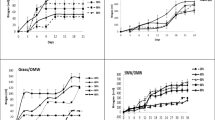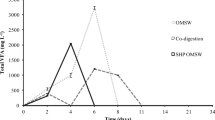Abstract
Anaerobic digestion (AD) is one of the most efficient processes for treating agri-food waste in order to obtain renewable energy. Olive mill solid waste (OMSW) is the main residue from the two-phase olive oil manufacturing process; it has a high organic content and high C/N ratio, which hinders its AD, giving low methane yield. In the present study, a microalga, Scenedesmus quadricauda, was used as co-substrate for the AD of OMSW to compensate for its nitrogen deficiency. The robustness and the high growth rate of S. quadricauda make this microalga a potential source of nitrogen to co-digest with carbon-rich substrates. Different co-digestion mixtures of OMSW-microalgae and the single substrates were tested. For all co-digestion mixtures, the alkalinity value at the end of the experiment remained below 4889 ± 245 mg CaCO3 L−1 and pH in the range of 7.50–7.67 indicating stability and good process performance. Results showed the highest methane yield (461 mL CH4 STP g−1 VS added) for the co-digestion mixture 75% OMSW-25% S. quadricauda (C/N = 25.3), which was 104 and 23% higher than that obtained from the single microalga (C/N = 5.6) and OMSW (C/N = 31.9), respectively. No ammonia inhibition was detected despite the high protein content of the microalgae. The transference function model allowed for adequately fitting the experimental results of methane production with time in the anaerobic experiments. The highest maximum methane production rate, Rm, among the different co-digestion mixtures assayed was obtained for the mixture 75% OMSW-25% S. quadricauda with a value of 89 mL CH4 g−1 VS day−1.

Similar content being viewed by others
References
Ajeej A, Thanikal JV, Narayanan C, Kumar RS (2015) An overview of bio augmentation of methane by anaerobic co-digestion of municipal sludge along with microalgae and waste paper. Renew Sust Energy 50:270–276
Ambarsari H, Adrian R, Manurung BS (2018) Anaerobic Biogas Production Using Microalgae Chlorella sp. as Biomass Co-digested by Cow Manure and Cow Rumen Fluid as Inoculum. IOP Conference Series: Earth Environ Sci 209: 012053
APHA–AWWA–WPCF (1998) Standard methods for the examination of water and wastewater, 20th edn. American Public Health Association, American Water Works Association and Water Environmental Federation, Washington DC
Barua VB, Rathore V, Kalamdhad AS (2019) Anaerobic co-digestion of water hyacinth and banana peels with and without thermal pretreatment. Renew Energ 134:103–112
Carminati P, Gusmini D, Pizzera A, Catenazzi A, Parati K, Ficara E (2018) Biogas from mono- and co-digestion of microalgal biomass grown on piggery wastewater. Water Sci Technol 78:103–113
Chen Y, Cheng JJ, Creamer KS (2008) Inhibition of anaerobic digestion process: a review. Bioresour Technol 99:4044–4064
Chen JL, Ortiz R, Steele TWJ, Stuckey DC (2014) Toxicants inhibiting anaerobic digestion: a review. Biotechnol Adv 32:1523–1534
Donoso-Bravo A, Perez-Elvira SI, Fernández-Polanco F (2010) Application of simplified models for anaerobic biodegradability tests. Evaluation of pre-treatment processes. Chem Eng J 160:607–614
Fannin KF, Biljetina R (1987) Reactor design. In: Chynoweth DP, Isaacson R (eds) Anaerobic digestion of biomass. Elsevier Applied Science, London, pp 109–128
Fernández-Rodríguez MJ, Rincón B, Fermoso FG, Jiménez AM, Borja R (2014) Assessment of two-phase olive mill solid waste and microalgae co-digestion to improve methane production and process kinetics. Bioresour Technol 157:263–269
González-González LM, Correa DF, Ryan S, Jensen PD, Pratt S, Schenk PM (2018) Integrated biodiesel and biogas production from microalgae: towards a sustainable closed loop through nutrient recycling. Renew Sust Energ Rev 82:1137–1148
Gunay A, Karadag D (2015) Recent developments in the anaerobic digestion of olive mill effluents. Process Biochem 50:1893–1903
Habiba L, Hassib B, Moktar H (2009) Improvement of activated sludge stabilization and filterability during anaerobic digestion by fruit and vegetable waste addition. Bioresour Technol 100:1555–1560
Holliger C, Alves M, Andrade D, Angelidaki I, Astals S, Baier U, Bougrier C, Buffière P, Carballa M, De Wilde V, Ebertseder F, Fernández B, Ficara E, Fotidis I, Frigon J, De Laclos HF, Ghasimi DSM, Hack G, Hartel M, Heerenklage J, Horvath IS, Jenicek P, Koch K, Krautwald J, Lizasoain J, Liu J, Mosberger L, Nistor M, Oechsner H, Oliveira JV, Paterson M, Pauss A, Pommier S, Porqueddu I, Raposo F, Ribeiro T, Pfund FR, Strömberg S, Torrijos M, Van Eekert M, Van Lier J, Wedwitschka H, Wierinck I (2016) Towards a standardization of biomethane potential test. Water Sci Technol 74:2515–2522
Iza J (1995) Control del proceso anaerobio. I Curs d’enginyeria ambiental. Universitat de Lleida, Lleida, pp 175–201
Khatib A, Aqra F, Yaghi N, Subuh Y, Hayeek B, Musa M, Basheer S, Sabbah I (2009) Reducing the environmental impact of olive mill wastewater. Am J Environ Sci 5:1–6
de la Lama D, Borja R, Rincón B (2017) Performance evaluation and substrate removal kinetics in the semi-continuous anaerobic digestion of thermally pretreated two-phase olive pomace or “Alperujo”. Process Saf Environ Prot 105:288–296
Li L, Kong X, Yang F, Li D, Yuan Z, Sun Y (2012) Biogas production potential and kinetics of microwave and conventional thermal pretreatment of grass. Appl Biochem Biotechnol 166:1188–1191
Li Y, Li Y, Zhang D, Li G, Lu J, Li S (2016) Solid state anaerobic co-digestion of tomato residues with dairy manure and corn Stover for biogas production. Bioresour Technol 217:50–55
Lu D, Zhang XJ (2016) Biogas production from anaerobic co-digestion of microalgae and septic sludge. J Environ Eng 142:40–49
Lv J, Wang X, Feng J, Liu Q, Nan F, Jiao X, Xie S (2019) Comparison of growth characteristics and nitrogen removal capacity of five species of green algae. J Appl Phycol 31:409–421
Maamir W, Ouahabi Y, Poncin S, Li H, Bensadok K (2017) Effect of Fenton pretreatment on anaerobic digestion of olive mill wastewater and olive mill solid waste in mesophilic conditions. Int J Green Energy 14:555–560
Mussgnug JH, Klassen V, Schlüter A, Kruse O (2010) Microalgae as substrates for fermentative biogas production in a combined biorefinery concept. J Biotechnol 150:51–56
Nguyen AQ, Wickham R, Nguyen LN, Phan HV, Galway B, Bustamante H, Nghiem LD (2018) Impact of anaerobic co-digestion between sewage sludge and carbon-rich organic waste on microbial community resilience. Environ Sci: Water Res Technol 4:1956–1965
Østergaard N (1985) Biogasproduktion i det thermofile temperaturinterval. STUB rapport nr. 21. Kemiteknik. Dansk Teknologisk Institut, Taastrup (in Danish)
Pantziaros AG, Jaho S, Karga I, Iakovides IC, Koutsoukos PG, Paraskeva CA (2018) Struvite precipitation and COD reduction in a two-step treatment of olive mill wastewater. J Chem Technol Biotechnol 93:730–735
Pinto-Ibieta F, Serrano A, Jeison D, Borja R, Fermoso FG (2016) Effect of cobalt supplementation and fractionation on the biological response in the biomethanization of olive mill solid waste. Bioresour Technol 211:58–64
Ramos-Suárez JL, Martínez A, Carreras N (2014) Optimization of the digestion process of Scenedesmus sp. and Opuntia maxima for biogas production. Energy Convers Manag 88:1263–1270
Raposo F, de la Rubia MA, Borja R, Alaiz M (2008) Assessment of a modified and optimised method for determining chemical oxygen demand of solid substrates and solutions with high suspended solid content. Talanta 76:448–453
Rincón B, Sánchez E, Raposo F, Borja R, Travieso L, Martín MA, Martín A (2008) Effect of the organic loading rate on the performance of anaerobic acidogenic fermentation of two-phase olive mill solid residue. Waste Manag 28:870–877
Rincón B, Fernández-Rodríguez MJ, de la Lama-Calvente D, Borja R (2018) The influence of microalgae addition as co-substrate in anaerobic digestion processes. In: Jacob-Lopes E, Zepka Q, Queiroz MI (eds) Microalgal Biotechnology. IntechOpen, Riejeka, pp 59–90
Rippka R, Deruelles J, Waterbury JB (1979) Generic assignments, strain histories and properties of pure cultures of cyanobacteria. J Gen Microbiol 111:1–61
Solé-Bundó M, Eskicioglu C, Garfi M, Carrère H, Ferrer I (2017) Anaerobic co-digestion of microalgal biomass and wheat straw with and without thermo-alkaline pretreatment. Bioresour Technol 237:89–98
Solé-Bundó M, Salvadó H, Passos F, Garfí M, Ferrer I (2018) Strategies to optimize microalgae conversion to biogas: co-digestion, pretreatment and hydraulic retention time. Molecules 23:E2096
Sousa D, Venâncio A, Belo I, Salgado JM (2018) Mediterranean agro-industrial wastes as valuable substrates for lignocellulolytic enzymes and protein production by solid-state fermentation. J Sci Food Agric 98:5248–5256
Takeda H (1996) Cell wall sugars of some Scenedesmus species. Phytochemistry 42:673–675
Wang JY, Liu XY, Kao JCM, Stabnikova O (2006) Digestion of pre-treated food waste in a hybrid anaerobic solid-liquid (HASL) system. J Chem Technol Biotechnol 81:345–351
Wong YK, Yung KK, Tsang YF, Xia Y, Wang L, Ho KC (2015) Scenedesmus quadricauda for nutrient removal and lipid production in wastewater. Water Environ Res 87:2037–2044
Xie S, Higgins MJ, Bustamante H, Galway B, Nghiem L (2018) Current status and perspectives on anaerobic co-digestion and associated downstream processes. Environ Sci: Water Res Technol 4:1759–1770
Xu J, Zhao Y, Zhao G, Zhang H (2015) Nutrient removal and biogas upgrading by integrating freshwater algae cultivation with piggery anaerobic digestate liquid treatment. Appl Microbiol Biotechnol 99:6493–6501
Xue B, Zifu L, Xuemei W, Xi H, Shikun C, Xiaofeng B, Ruiling G (2017) Online measurement of alkalinity in anaerobic co-digestion using linear regression method. Int J Agric Biol Eng 10:176–183
Yen HW, Brune DE (2007) Anaerobic co-digestion of algal sludge and waste paper to produce methane. Bioresour Technol 98:130–134
Yenigün O, Demirel B (2013) Ammonia inhibition in anaerobic digestion: a review. Process Biochem 48:901–911
Zhang J, Wang S, Lang S, Xian P, Xie T (2016) Kinetics of combined thermal pretreatment and anaerobic digestion of waste activated sludge from sugar and pulp industry. Chem Eng J 295:131–138
Zhang Q, Chang C, Bai J, Fang S, Zhuang X, Yuan Z (2018) Mutants of Scenedesmus sp. for purifying highly concentrated cellulosic ethanol wastewater and producing biomass simultaneously. J Appl Phycol 30:969–978
Zhang Y, Caldwell GS, Zealand AM, Sallis PJ (2019) Anaerobic co-digestion of microalgae Chlorella vulgaris and potato processing waste: effect of mixing ratio, waste type and substrate to inoculum ratio. Biochem Eng J 143:91–100
Zhen G, Lu X, Kobayashi T, Kumar G, Xu K (2016) Anaerobic co-digestion on improving methane production from mixed microalgae (Scenedesmus sp., Chlorella sp.) and food waste: kinetic modeling and synergistic impact evaluation. Chem Eng J 289:322–341
Funding
The authors wish to express their gratitude to the regional government of Andalucía, Junta de Andalucía, Consejería de Economía y Conocimiento (Project of Excellence RNM-1970) for providing financial support. Dr. Rincón-Llorente wishes to thank the “Ramón y Cajal” Program (RYC-2011-08783 contract) from the Spanish Ministry of Economy and Competitiveness for providing financial support.
Author information
Authors and Affiliations
Corresponding author
Additional information
Publisher’s note
Springer Nature remains neutral with regard to jurisdictional claims in published maps and institutional affiliations.
Rights and permissions
About this article
Cite this article
Fernández-Rodríguez, M.J., de la Lama-Calvente, D., Jiménez-Rodríguez, A. et al. Anaerobic co-digestion of olive mill solid waste and microalga Scenedesmus quadricauda: effect of different carbon to nitrogen ratios on process performance and kinetics. J Appl Phycol 31, 3583–3591 (2019). https://doi.org/10.1007/s10811-019-01858-x
Received:
Revised:
Accepted:
Published:
Issue Date:
DOI: https://doi.org/10.1007/s10811-019-01858-x




